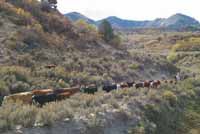| Cattle grazing and its continuation is a concern for the council. |
At the October Public Lands Council meeting, Dickson Huntington, grazing subcommittee chairman expressed concern over grazing and the upcoming BLM resource management plan for the San Rafael Swell and the Price River District.
Huntington said that Rex Sacco, grazing advocate, from Price had faxed them some information that the BLM was going to be retiring active grazing permits as part of the RMP plan. The RMP process is currently underway and a series of alternatives are being developed. Huntington maintained that legally the BLM cannot retire grazing permits and it takes Congressional action to do these things.
Actions like were taken in the Grand Staircase Escalante National Monument where conservation groups purchased grazing permits and then retired them should never have been done. Actions like this are illegal under the Taylor Grazing Act. Lands adjudicated for grazing must be used for grazing.
Craig Johansen said if actions are taking place which are contrary to what grazers think, they need to be active in the RMP process and make sure their concerns are made known. The three allotments that are being considered for retirement are currently closed to grazing. One such allotment was in the Buckhorn Draw. Johansen said there could be grounds for legal action if the BLM were to retire these units.
Dennis Worwood, council chairman, said that as the BLM develops the different alternatives for the RMP that grazing might be addressed differently in each alternative. Floyd Johnson from the BLM said that the alternatives are currently in Washington being looked at for further input. He pointed out that the alternatives are a first draft and that input from the public will be gathered at public hearings to be incorporated into a final draft which will again be subject to public input.
Huntington emphasized the need to get involved in this BLM process and to make sure comments are made with the concerns of the grazers outlined. He said that in the history of the permittees things have been bleak and the cattlemen often end up losing ground. He pointed out that in the last RMP a lot of grazing was phased out, the grazing board was lost as well as spring grazing was eliminated. “This was devastating to the cattlemen,” said Huntington. “We need to take a stand right now, or they will get what they want. The lands council should take a stand that we will accept no loss of AUMs and stick to it. We should advise that the BLM strictly adhere to the Taylor Grazing act and not divert from it. I’m not talking about temporary reductions for the drought, we can live with that, but the RMP will be good for 15 years or so.”
Board member, Tory Killian suggested the rallying of local cattlemen with education and awareness of the issue. Huntington said they have been doing that and will continue to do so. He said that Sacco said for each animal taken off the ground the economy of an area loses $1,100 in goods and services. The Icelander allotment was recently fought over and the grazers won. A defeat here would of resulted in a loss of approximately $1 million for the economy.
Johnson said that they are looking at four alternatives now and that in the end a preferred alternative is likely to contain a mix of all four.
Worwood mentioned that monitoring of the allotments is key to defending your positions. In the case with the Icelander allotment, the Jensen family had better documentation than was being used and were in a position to defend their allotment. In riparian areas along the San Rafael River it was proven that the plants that were growing there would not have been able to exist if the area were overgrazed. He stressed the need to have vital, correct information about your allotment and not to make assumptions.
It was determined that the lands council would invite Sacco to attend a public lands council meeting to keep the council updated on attacks on grazing.

